The Land Of China -- Explore by Province
Shaanxi
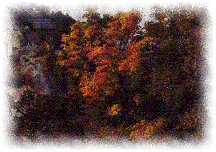 Shaanxi Landscape
Shaanxi Landscape
|
Shaanxi Province is situated in the center of China, and the geological center point of China is just located within Jingyang County in the province. Shaanxi is 1,000 kilometers long and 360 kilometers wide. Adjacent to Shanxi is Henan, Hubei, and Shanxi to the south and east; Sichuan and Gansu to the south and west; and Ningxia and lnner Mongolia to the north. Shaanxi serves as the vital communication junction, linking the eastern and central parts to the southwestern and northwestern parts of China. The province covers an area of 205,600 square kilometers and is divided into three natural areas from the north to the south, namely the Northern Plateau, the Guanzhong Plain, and the Qinba Mountainous Region.
Shaanxi is a world-known province for its most valuable, historical relics. The province has very good tourist facilities with 32 tourism agencies of the first and second classes; 80 tourism agencies of the third class that are involved in domestic service; and more than 2,000 tour guides with languages of English, French, German, Italian, Russian, Korean, and Vietnamese. The ancient and cultural city, Xi'an, also the province's capital, is full of various and colourful night recreational activities.
Xi'an conveys the continuity of Chinese civilization most clearly to the stranger. Three-thousand-year-old Xi'an was the capital of 11 dynasties for a total of 1,080 years, the most important of which were the Zhou, Qin, Han, Sui, and Tang. It is situated in a fertile basin south of the Wei He river and north of the Qinling massif and lies on the eastern end of the famous Silk Road. Xi'an, which was inhabited by many merchants from Central Asia, already had a million residents during the Tang Dynasty. Today, the population is 2. 94 million, and Xi'an is considered to be one of the largest economic and cultural centers in Northwest China.
 Xian and the Big Wild Goose Pagoda
Xian and the Big Wild Goose Pagoda
|
Due to its long history, Xi'an offers tourists many historical sights. About six kilometers east of Xi'an one can observe traces of early settlements from the Neolithic era in Banpo Cun, a village attributed to the Yangshao culture.
The Big Wild Goose Pagoda is located in Ci'en Temple in the south of Xi'an and is the symbol of the city. Built in 652 during the Tang Dynasty, it was used to safekeep the 657 volumes of Buddhist scriptures brought back from India by the Monk Xuan Zhang. The seven floor, 59.9-meter-high pagoda is pyramidal with each side of the ground floor 25 meters in length. It stands on a square base 48.8 meters long, 45.9 meters wide and 4.2 meters high.
 Mausoleum of the First Emperor
Mausoleum of the First Emperor
|
The Mausoleum of the First Emperor Qin Shihuang is located 5 km away from Lintong County seat with Lishan Mountain to the south and the Wei River to the north. It is the mausoleum of China's first Emperor Qin Shihuang (259-210BC), who was the first to unite the country.
The construction lasted 37 years. It is 76 meters high and has a circumference of 2, 000 meters. Surveys show the mausoleum is composed of inner and outer cities. The inner city has a circumference of 2,525 meters, the outer city is 6,264 meters. Three vaults of terracotta warriors and horses have been discovered east of the tomb. Two sets of bronze chariots and horses and bronze figures have been excavated west of it. In 1987 UNESCO listed it as a World Heritage Site.
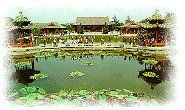 Huaqing Hot Springs
Huaqing Hot Springs
|
The Huaqing Hot Springs, also called 'Star Pool', are situated at the foot of the Lishan Mountain and have been famous since the ancient times. In the Zhou Dynasty 2,800 years ago, it got its present name in the Tang Dynasty (747). A large scale construction in 1959 recreated the palace-like buildings and imitations of Jiulong Tang (Nine Dragon Pool). In 1990, a Museum of Huaqing Palace Imperial pool was opened. Made up of the Lotus Flower Pool or Imperial Pool, Crab-Apple Pool or Guifei (concubine) Pool, Star Pool, Staff Pool and Prince Pool with a floor space of 1,800 square meters, it has regained its magnificence of the Tang hey-day.
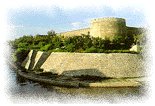 the City Wall of Xi'an
the City Wall of Xi'an
|
The City Wall of Xi'an was built during the Tang Dynasty and is the only complete city wall that is extended in China. The rectangular wall is 11.9 km long, 12 meters high, 12-14 meters wide on top, and 15-18 meters wide at the base. There are 5,894 crenels along the exterior wall, but no crenels on the interior side. Turrets are at the four corners and each side has a gate. On top of the gates are main towers and watchtowers. A moat protects the perimeter and you can take a walk on the wall or go fishing by the moat.
 the Qianling Tomb
the Qianling Tomb
|
Lying on Liangshan Hill north of Qianxian County seat is the joint mausoleum of Tang Emperor Gaozong (Li Zhi) and his consort Empress Wu Zetian. It once had two walls, but now only the inner wall and Xian Hall remain. The wall is 5,920 meters long and 2.4 meters thick with gates and giant stone carvings. The stone carvings near the South Gate are still in good condition, including huabiao (cloud pillars), birds and animals, 6.3-meter-high stone pillars and 61 stone statues of foreign envoys and chieftains of national minorities who attended the funeral of the emperor.
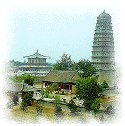 the Famen Temple
the Famen Temple
|
Situated in Famen Town north of Fufeng County seat, this Famen Temple was built in the Eastern Han Dynasty (25220) to safekeep fingerbone relics of Sakyamuni. In the temple there was a brick tower which collapsed in 1981. An underground palace was discovered in 1987, the largest Buddhist underground palace ever found in China. There are many precious treasures there and the four relics of Buddha's fingerbones have been appraised to have belonged to Sakyamuni. Altogether there are more than 2,400 pieces of gold and silver wares, glazed wares, porcelain and pottery wares, jewelry and textile products of the Tang imperial court.
the Terracotta Warriors
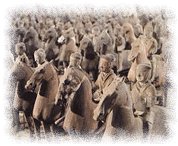 the Terracotta Warriors
the Terracotta Warriors
|
Jacques Shirac, former president of France, once said: "One can't claim to have visited China unless one has seen the Terracotta Warriors."
Shirac predicted that the Qin terracotta warriors would become a major historical site that would attract overseas tourists to China. He was right: the number of tourists to Shaanxi in Northwest China has increased steadily in the past 23 years since the terracotta figurines were first discovered. A report in the United Evening News of Singapore said that all leaders from other countries who visit Beijing find it a great pleasure to go to Xi'an and see the terracotta warriors. What is the reason for the Qin figurines to enjoy such great popularity? Let us go to the Museum and see why the Qin Terracotta Warriors are one of world's main attractions.
 6,000 Life-Size
6,000 Life-Size
Terracotta Warriors
|
The museum covers an area of 14,000 square meters. Stepping into it, one arrives at Pit No. 1, which contains 6,000 life-size terracotta warriors and horses. The impressive sight of figurines lined in neat formation grips the spectators with grandeur and magnificence and captures their admiration. People often ask: Why did Qin Shi Huang, the emperor who founded the Qin Dynasty in 221 B.C., use so many large terracotta figurines as funerary objects?
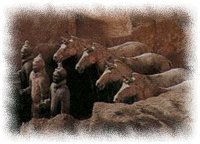 Slave and Horse Figurines
Slave and Horse Figurines
|
During the Shang and Zhou dynasties (16th to 3rd centuries B.C.), slaves were buried alive with their owners and aristocrats when they died. The number of slaves immolated depended on the status of the deceased. More than 60 slaves were sacrificed when Duke Wu, the ruler of the State of Qin, died in 678 B.C. Later, 177 slaves were immolated when Duke Mu died in 621 B.C. The practice aroused indignation among the people of Qin, and Duke Xian had it banned when he ascended the throne of the State of Qin in 384 B.C. While still regarding slaves as chattels, the slave-owners had to replace the living slaves with figurines, using them as funerary objects.
 6,000 Warriors Protecting Qin
6,000 Warriors Protecting Qin
|
So why did Qin Shi Huang decide to use the warriors and horses as funerary objects? It was believed that a person should be buried with the objects he regarded as most valuable in his lifetime so that he could continue to enjoy them in the underworld. Historically, phalanxes, or close-knit bodies of people, were formed in line with military tactics. Such formations appear in the tomb of Qin Shi Huang. Mrs. Ronald Reagan said that it was incredible to see that the formation of 6,000 warriors and horses were meant to protect the owner of the tomb. The reason why Qin Shi Huang used the life-size figurines was because he believed that he had to unify all of China; he wanted to lead his army into the netherworld to protect his spirit and perpetuate his rule.
Here is a list of other great tourist spots in Shaanxi:
 the Hua Shan Mountain
the Hua Shan Mountain
|
- the well-known "Number One Mountain under the Heavens," the Huashan Mountain
- the well-known "First Mausoleum of the World," which is the Mausoleum of Xuan Yuan Yellow Emperor, the ancestor of the Chinese nation
- the oldest Great Mosque in typical Chinese-style architecture. It contains an unmatchable and complete Koran carved on wooden plates
- the most modern state museum, Shaanxi History Museum. It contains the oldest, biggest, and richest stone library - the Xi'an Forest of Stone Tablets
- the famous cradle of the Chinese revolution - Yan'an
Other historical sites in Shaanxi include the birth place of Yan Emperor Jiang Shuiyu and the burial place, Ding Jing Shan, of Zhuge Liang. Tourists have enjoyable visits to the Shaanxi Province, for they are intrigued by its Emperor palace and garden, mausoleums, famous pagodas and ancient temples, beautiful mountains, and simple and traditional folk customs.



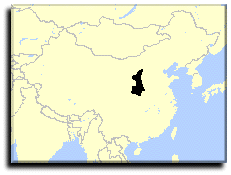
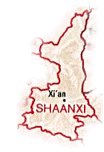















 Chinese Culture
Chinese Culture